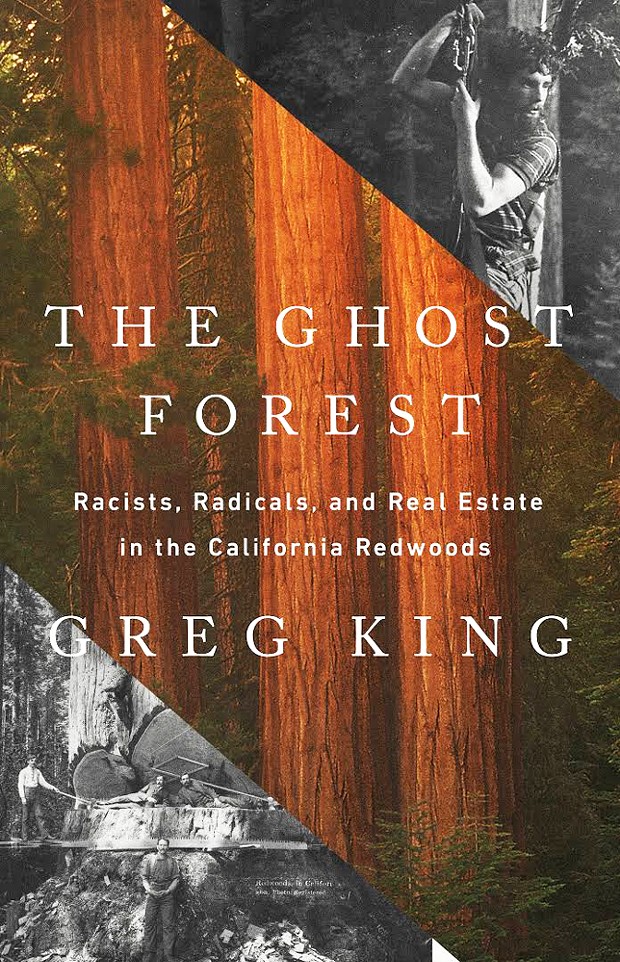
The Ghost Forest
[
{
"name": "Top Stories Video Pair",
"insertPoint": "7",
"component": "17087298",
"parentWrapperClass": "fdn-ads-inline-content-block",
"requiredCountToDisplay": "1"
}
]
Likely to become a classic, Greg King's first solo book The Ghost Forest is aptly titled — a must-read that deftly chronicles how 96 percent of California's old growth redwood forests fell to the saw.
The award-winning journalist begins his complex, multi-generational narrative with his own entry into environmental activism. In 1986, while researching logging for The Paper in his hometown of Guerneville, King visits Humboldt County, meets forest defender Darryl Cherney, and sees clear-cuts first-hand. The year before, Charles Hurwitz, the new owner of Pacific Lumber, had completed a hostile takeover of the company, tripling the liquidation of its old growth. Appalled, King joins Earth First! and becomes a forest defender, participating in protests, tree sits and a failed attempt to hang a banner from the Golden Gate Bridge. That story ends bittersweetly: Ultimately the state and federal governments buy and protect Headwaters Forest, but fellow activist Judi Bari and Cherney fall victim to a car bombing and then, in a bizarre twist, are framed by the Oakland Police and the FBI for supposedly transporting the very bomb meant to kill them. Bari and Cherney successfully sue both entities, but no one is ever caught and charged for the crime, and Bari dies of breast cancer before the case is resolved.
King mirrors that narrative with the history of how wealthy financiers fraudulently obtained vast tracts of old growth redwood all over Northern California by abusing a federal homesteading law, allowing public lands to flow into private hands at minimal cost. King then tells how government became a cheerleader for clear cutting, creating laws to limit destructive logging practices but then turning a blind eye to environmental devastation. The California Department of Forestry (CDF), established in 1973, would approve almost any Timber Harvest Plan (THP) regardless of how it violated the law; tasked with protecting the environment, CDF failed to do so until it was sued by the Environmental Protection and Information Center (EPIC). In a series of landmark judgments that blocking THPs, enough political pressure was finally exerted to force CDF to enforce the Endangered Species Act. Ultimately Hurwitz was prevented from legally logging in the Headwaters.
King parallels the modern-day history of the Timber Wars with the early-20th century history of how a handful of wealthy white industrialists responded to the threat of environmental activism. Gathering at the Bohemian Grove in 1917, they created one of the first greenwashing organizations, Save the Redwoods League, which for decades helped timber companies liquidate old growth forests, buy timberland at inflated prices, and consistently lobby against efforts to create large parks to protect old growth. Even then, the league would purchase only small acreages of redwoods — often second growth façades to shield motorists from clear cuts. As if the false public face of environmental defense wasn't bad enough, King also describes how the organization's "progressive" leadership was tainted by eugenicists who applauded the Nazi regime for the Holocaust. In fact, one of the League's ardent financial supporters, Charles M. Goethe, established the Eugenics Society of Northern California. Over a period of 40 years, this organization led to more than 20,000 people in California being forcefully sterilized, many unknowingly.
The book is not all tragedy, however. King tells how the Sierra Club successfully lobbied for the creation of Redwood National Park, overcoming the roadblocks that Save the Redwoods League put in its way. Decades later, this action was echoed in the creation of the Headwaters Reserve, when the state and federal governments purchased 7,472 acres to protect it for perpetuity. Still, King argues these victories were Pyrrhic: Much more old growth could have been saved in the Redwood Creek watershed when Redwood National Park was established, and when the Headwaters Reserve was purchased, Sen. Dianne Feinstein, influenced by Save the Redwoods, wound up a terrible negotiator. The state and federal governments ultimately paid Charles Hurwitz about 10 times what the forest was worth.
In considering how California's old growth redwood forests were liquidated due to greed, corruption, influence peddling, violence and lies, King doesn't shy away from the tragedy of the destruction. But wielding sharp prose, essential research skills and an unblinking eye for both the horror of clear-cutting and the indescribable beauty of what remains, he also presents us with numerous people who embody courage, wisdom and grace in fighting against such destructive and corrupting influences. And he stands among them. For anyone concerned with the environment and its defense, this book is an essential read.
David Holper (he/him) served as the first poet laureate for the city of Eureka and is faculty emeritus from College of the Redwoods.
Speaking of...
-

David's Chair Blazes Accessible Trails in Prairie Creek Redwoods
Oct 5, 2023 -

Darwin's Bulldog
Sep 28, 2023 -

Forest Moon Festival to Celebrate Return of the Jedi's 40th
Apr 1, 2023 - More »































